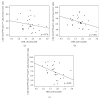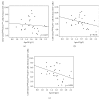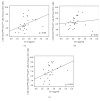Not Only Glycaemic But Also Other Metabolic Factors Affect T Regulatory Cell Counts and Proinflammatory Cytokine Levels in Women with Type 1 Diabetes
- PMID: 28553653
- PMCID: PMC5434466
- DOI: 10.1155/2017/5463273
Not Only Glycaemic But Also Other Metabolic Factors Affect T Regulatory Cell Counts and Proinflammatory Cytokine Levels in Women with Type 1 Diabetes
Abstract
Type 1 diabetic (T1D) patients suffer from insulinopenia and hyperglycaemia. Studies have shown that if a patient's hyperglycaemic environment is not compensated, it leads to complex immune dysfunctions. Similarly, T1D mothers with poor glycaemic control exert a negative impact on the immune responses of their newborns. However, questions concerning the impact of other metabolic disturbances on the immune system of T1D mothers (and their newborns) have been raised. To address these questions, we examined 28 T1D women in reproductive age for the relationship between various metabolic, clinical, and immune parameters. Our study revealed several unexpected correlations which are indicative of a much more complex relationship between glucose and lipid factors (namely, glycosylated haemoglobin Hb1Ac, the presence of one but not multiple chronic diabetic complications, and atherogenic indexes) and proinflammatory cytokines (IL-1alpha and TNF-alpha). Regulatory T cell counts correlated with HbA1c, diabetic neuropathy, lipid spectra parameters, and IL-6 levels. Total T-helper cell count was interconnected with BMI and glycaemia variability correlated with lipid spectra parameters, insulin dose, and vitamin D levels. These and other correlations revealed in this study provide broader insight into the association of various metabolic abnormalities with immune parameters that may impact T1D mothers or their developing child.
Figures











Similar articles
-
T Helper 22 Pathway Evaluation in Type 1 Diabetes and Its Complications.Iran J Allergy Asthma Immunol. 2018 Jun;17(3):258-264. Iran J Allergy Asthma Immunol. 2018. PMID: 29908543
-
Glycaemic control influences the relationship between plasma PCSK9 and LDL cholesterol in type 1 diabetes.Diabetes Obes Metab. 2017 Mar;19(3):448-451. doi: 10.1111/dom.12819. Epub 2016 Dec 8. Diabetes Obes Metab. 2017. PMID: 27804190
-
[Relationship between nitrogen oxide and the degree of metabolic control of diabetes mellitus type 1 in children and adolescents].Wiad Lek. 2006;59(1-2):27-31. Wiad Lek. 2006. PMID: 16646288 Polish.
-
Anti-cytokine therapies in T1D: Concepts and strategies.Clin Immunol. 2013 Dec;149(3):279-85. doi: 10.1016/j.clim.2013.02.003. Epub 2013 Feb 14. Clin Immunol. 2013. PMID: 23510726 Free PMC article. Review.
-
Diabetes technology and treatments in the paediatric age group.Int J Clin Pract Suppl. 2011 Feb;(170):76-82. doi: 10.1111/j.1742-1241.2010.02582.x. Int J Clin Pract Suppl. 2011. PMID: 21323816 Review.
Cited by
-
New Developments in T Cell Immunometabolism and Therapeutic Implications for Type 1 Diabetes.Front Endocrinol (Lausanne). 2022 Jun 10;13:914136. doi: 10.3389/fendo.2022.914136. eCollection 2022. Front Endocrinol (Lausanne). 2022. PMID: 35757405 Free PMC article. Review.
-
A new ratio derived from inflammasome markers can serve as a marker of assessment of glycemic index in children with Type 1 diabetes.J Res Med Sci. 2022 Feb 18;27:14. doi: 10.4103/jrms.JRMS_773_18. eCollection 2022. J Res Med Sci. 2022. PMID: 35342451 Free PMC article.
-
Cell Based Therapy for Type 1 Diabetes: Should We Take Hyperglycemia Into Account?Front Immunol. 2019 Feb 5;10:79. doi: 10.3389/fimmu.2019.00079. eCollection 2019. Front Immunol. 2019. PMID: 30804929 Free PMC article. Review.
References
MeSH terms
Substances
LinkOut - more resources
Full Text Sources
Other Literature Sources
Medical

